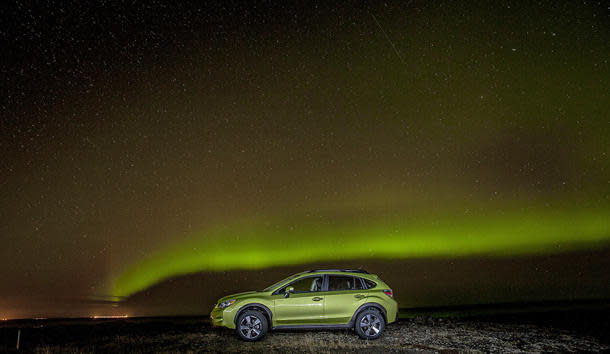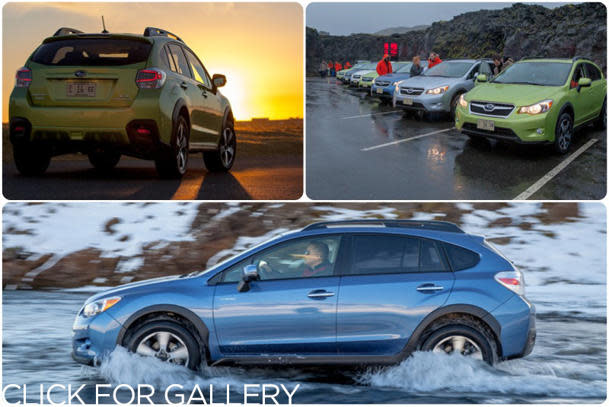 Motoramic
Motoramic2014 Subaru XV Crosstrek Hybrid, the Iceland experience: Motoramic Drives
In Iceland, there’s a legend of men (and a couple of women) who came from far away to seek adventure, driving cars up volcanic slopes and into frozen rivers. Subaru summoned us for this task, and we answered like a herd of mountain sheep. We flew to the island inside great metal birds, soaked in hot springs like happy trolls, ate whale and horse, and, more than once, almost drove off a mountain during a blizzard.
The cars were all-new XV Crosstrek Hybrids, the first hybrid model made by Subaru. Frankly, the hybrid Crosstrek could have just as easily been showcased at a Colorado off-road park or Dallas mall parking lot, but Subaru’s enjoying a great sales boom in North America, and felt like celebrating someplace exotic. They thought Iceland would be a fun place to showcase the Crosstrek’s all-wheel-drive versatility.
The drive was supposed to occur in September, but the cars weren’t ready yet. October passed, and still the Crosstreks didn’t appear on Iceland’s shores. Then, two days before we were scheduled to arrive, during the first week of November, Iceland got its first major winter storm, setting the scene for a treacherous voyage into the heart of an icy doomscape that even the most arrogant explorers would have avoided.
But on the trip’s first day, the weather held, more or less. The Arctic winds blew at a modest 40 mph through the moss-covered lava flatlands. This offered our best chance to evaluate the actual strengths and weaknesses of the vehicle, which was, putatively, the reason that we’d flown halfway across the Atlantic.
We drove our Crosstreks along dirt and gravel roads cut out of lava fields, dumping fuel and rubber into a low-flowing river that we crossed at least two-dozen times. It was only moderately harsh off-roading, but the Crosstrek’s AWD system handled everything smoothly. The Crosstrek offered modest amenities, an average rear storage capacity, and extra fuel economy thanks to a small, 0.6 kWh nickel-hydride battery, which were popular in Toyota Prius hybrids ten years ago, but now seem dated compared with the lithium-ion industry norm.
These small vehicles are inexpensive by current car industry standards, starting at $25,000-plus. Fully-loaded, they’ll run a little more than $30,000, which is a little more than they should cost. Subaru promises they’ll get 29 mpg city/33 mpg highway, which seems possible. That would put them at the top of their narrow hybrid sub-segment, though at the bottom of the hybrid segment overall, and only about 2 mpg more combined than the non-hybrid Crosstreks.
But even though this is essentially the same car as the gas-powered model, 148-hp engine and all, the Crosstrek remains reasonably safe and relatively capable, if kind of dopey and nondescript. The hybrids will probably sell very well in Subaru’s usual markets. Also, if Subaru’s track record holds firm, they’ll run forever, assuming you don’t drive them into the heart of a North Atlantic ice storm. Even that, we learned the next day, was sort of within the XV Crosstrek’s capabilities.
The word “Ofaert” means “impassable” in Icelandic. I know this because our caravan of Crosstreks, many of them lime green, drove around several national park road barriers that read “Ofaert.” Our hearty, gravel-faced Icelandic guides, at least one of whom was named Gummi, didn’t seem to care. They sat inside monstrosities of the frozen north, Land Cruisers and Land Rover Defenders and Nissan Patrols with 45-inch tires and suspensions designed to plunge into the heart of a volcano. Our small Subaru CUVs, designed to go to a Costco in suburban Denver, were dust mites by comparison.
An hour after lunch, when the sun already hung ominously low in the grey, dead sky, I found myself blindly plunging the little Subaru into a snow trench, whose banks had been plowed high around both sides of the car. I wailed over moguls and around curves like I was riding on the Matterhorn. Then the caravan stopped. We all had walkie-talkies in our cars.
“Lead car is stuck,” we heard.
“Oh, boy,” I said.
“We’re high centered,” said the lead car.
“What does that mean?” I asked my drive partner.
“It means their wheels are off the ground,” he said.
Another voice came over the transom.
“Car Two is also stuck,” it said.
We were car four.
The guide cars merrily rumbled back and forth across the lava, attaching themslves to the lead Crosstreks, digging great ruts into the impassable mountain-park road.
“Clear to drive,” the radio said.
“Really?” I said.
One of our guides, who was only wearing a sweater and overalls, cheerily waved at us. I rollled down the window.
“Go fast,” he said. “You need to stay on the gas. You need momentum.”
We’d been receiving advice like that all day. One guy told us to turn the traction control on. Another told us to turn the traction control off. Either way, it didn’t matter, because the lead car always ended up getting high-centered. But it’s pretty much a cardinal rule of off-road driving: When all else fails, push the pedal to the floor.
I gunned it. The car roared forward. We buffeted off the snow walls.
“Whoo!” I said.
We drove around the bend.

 Yahoo Autos
Yahoo Autos 



